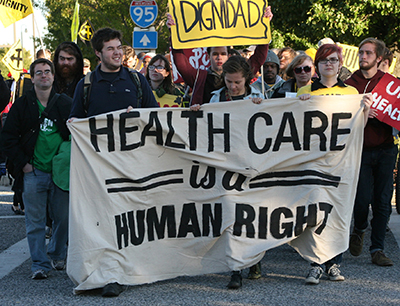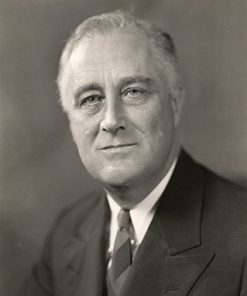On October 26, 2013, Marylanders from across the state marched for the human right to healthcare. It was the first state-wide action of the Healthcare Is a Human Right – Maryland campaign. And it was a powerful testament to the grassroots movement that is growing across the state to demand universal healthcare.
The United States, despite its wealth, treats healthcare as a business rather than a basic human necessity, making it the only major country where medical debt is a leading cause of bankruptcy.
The U.S. spends over $12,000 per person annually—more than any nation—yet ranks poorly in life expectancy, infant mortality, and preventable deaths. A 2017 study in The Lancet found that the U.S. had the highest rate of preventable deaths among high-income nations. This isn’t just inefficiency—it’s structural failure. Each year, healthcare costs drive over 500,000 American families into bankruptcy—and millions more delay or forgo care. The COVID-19 pandemic laid bare these flaws, hitting marginalized communities hardest.
Countries with universal healthcare achieve better outcomes at lower costs. Canada’s publicly funded system, free at the point of care, costs less and delivers better results. The UK’s National Health Service (NHS) is one of the most cost-effective models globally. Economist Mariana Mazzucato, in The Value of Everything, explains that public healthcare fosters innovation by prioritizing need over profit. Universal systems prevent financial ruin from illness, ensuring that no one dies because they couldn’t afford insulin or chemotherapy.
Critics decry inefficiency—yet the U.S. system is drowning in administrative waste. A 2020 study in Annals of Internal Medicine found that administration accounts for 34% of U.S. healthcare costs—double Canada’s 17%. Private insurers divert billions into lobbying, marketing, executive salaries, and bureaucracy rather than actual care. Countries with single-payer systems achieve lower drug prices through government negotiations, preventing the price gouging that plagues the U.S.
Critics also raise the issue of wait times. While some nations experience delays for non-urgent procedures, critical care access is often faster than in the U.S. In fact, Germany and the Netherlands—both with universal systems—have shorter specialist wait times than the U.S. These systems ensure that no one is left untreated, unlike the U.S., where patients can be denied care due to cost.
A profit-driven healthcare system disrupts the natural flow of care, creating barriers where there should be ease. Taoism teaches that harmony arises when systems work in balance—yet the U.S. model creates artificial scarcity, prioritizing corporate interests over public well-being. Universal healthcare restores this balance, aligning medicine with its true purpose: healing. The psychological benefits are also profound. In countries with universal coverage, people experience less financial anxiety about medical costs. A 2018 Health Affairs study linked medical debt directly to soaring rates of depression and anxiety..
Universal healthcare fosters social cohesion—treating health as a shared good, not a private privilege. It strengthens democracy by ensuring that no one’s survival depends on wealth. Healthy populations drive stronger economies; public healthcare cuts absenteeism and boosts participation. Medicare, despite being limited in scope, demonstrates this efficiency by negotiating lower costs than private insurers. Expanding it to all citizens would achieve similar savings at a national level.
Transitioning to universal healthcare does not mean starting from scratch. Expanding Medicare to cover everyone—often called Medicare for All—is a practical pathway supported by economists and health policy experts. Funding would involve redirecting current healthcare spending, implementing progressive taxation, and eliminating wasteful private insurance costs. The reality is that Americans already pay enough in healthcare taxes to fund a public system, yet they also pay exorbitant premiums, copays, and deductibles to maintain a for-profit model that leaves millions uninsured.
Providing Universal Healthcare is estimated to cost $3.4 trillion per year. This figure is lower than the current $4.3 trillion in total U.S. healthcare spending due to $200 billion in savings from renegotiated pharmaceutical prices, $300 billion from lower administrative expenses, and $400 billion from eliminating private insurance industry profits. Since $1.6 trillion annually is already spent on Medicare and Medicaid, only $1.8 trillion in additional funding is needed to transition to a universal system that covers all Americans.
1. 5% Gross Receipts Tax on Large Corporations
Applies to businesses with over $40B in annual revenue, ensuring that corporate giants contribute fairly to the public healthcare system. ($600B/year)
2. Reinvested Private & Public Premiums
Instead of paying premiums to private insurers, individuals and employers would pay into a public, nonprofit system at lower rates. since the system removes profits and waste. ($600B/year)
3. Value-Added Tax (VAT) on Luxury Goods
The estimated U.S. luxury market is $6 trillion per year. A 10% VAT on luxury goods and high-end services such as yachts, private jets, jewelry, and luxury travel, and high-end real estate transactions structured to affect the ultra-wealthy. ($600B/year)
Critics argue that universal healthcare limits choice, but the opposite is true. In nations with public systems, patients often have greater freedom to choose their doctors and hospitals, as they are not restricted by insurance networks. In contrast, U.S. private insurance plans dictate which providers people can see and impose bureaucratic hurdles like prior authorizations and claim denials. Universal healthcare removes these obstacles, ensuring that care is dictated by medical need, not corporate approval.
Countries with universal healthcare, like Norway, Japan, and Australia, consistently rank higher in health outcomes than the U.S. Japan’s hybrid system delivers high-quality care at low out-of-pocket costs, while Norway funds healthcare through taxation, ensuring equitable access. Cuba, despite limited resources, achieves impressive results through preventive care and community health initiatives. These examples prove that universal healthcare is not just about treating illness—it is about promoting long-term well-being.
The U.S. healthcare system also weakens pandemic preparedness. During COVID-19, nations with universal systems coordinated faster responses, while the U.S.’s fragmented model led to delays in testing, treatment, and vaccine distribution. In crises, a unified system ensures rapid, equitable response, whereas a privatized one prioritizes profit.
Implementing universal healthcare demands not just policy change—but a cultural shift. It challenges the deeply ingrained belief that healthcare should be bought and sold like a commodity. In Taoism, wu wei describes effortless action in harmony with natural order. A just healthcare system follows wu wei: letting care flow naturally to those in need, rather than being hoarded by those who can afford it.
THEREFORE, under Folklaw:
Healthcare shall be enshrined as a universal human right. A publicly funded, single-payer system shall provide comprehensive medical care to all residents—including preventive services, hospitalization, mental health care, dental and vision care, and prescription medications.
Financing shall come through progressive taxation, a Value Added Tax on luxury goods, and the reinvestment of private and public premiums. Private insurance shall be eliminated for basic healthcare but allowed for elective services.
Healthcare providers shall remain publicly and privately operated, ensuring patient choice within the universal framework. Administrative efficiency will be prioritized—cutting bureaucracy and focusing resources on actual care. Public health initiatives shall prioritize prevention, education, and community-based care—addressing the root causes of poor health.
Universal healthcare shall be insulated from privatization pressures through constitutional protections, ensuring that health remains a public right for future generations.
Resolution
A RESOLUTION TO GUARANTEE HEALTHCARE FOR ALL
SUBJECT: Establishing a publicly funded, single-payer healthcare system to ensure universal medical coverage, eliminate financial barriers to care, and prioritize patient well-being over corporate profit.
WHEREAS, healthcare is a fundamental human right, and access to medical care should not be determined by income, employment status, or geographic location;
WHEREAS, the United States spends more per capita on healthcare than any other nation—over $12,000 annually according to the OECD—yet ranks poorly in life expectancy, infant mortality, and preventable deaths;
WHEREAS, a 2017 study in The Lancet found that the U.S. had the highest rate of preventable deaths among high-income nations, demonstrating that the issue is not cost, but systemic inefficiency and profit-driven obstruction of care;
WHEREAS, over 500,000 families file for bankruptcy each year due to medical expenses, and millions of Americans delay or forgo necessary care due to cost, creating widespread financial and public health crises;
WHEREAS, countries with universal healthcare systems, including Canada, the United Kingdom, and Germany, achieve better health outcomes at lower costs, ensuring that no individual faces financial ruin due to illness;
WHEREAS, administrative costs in the U.S. healthcare system account for 34% of total spending—double that of countries with single-payer systems—demonstrating that private insurance bureaucracy, marketing, and executive salaries contribute to waste rather than care;
WHEREAS, Medicare already negotiates lower drug prices than private insurers, and expanding it to cover all citizens would reduce national healthcare costs while improving access and efficiency;
WHEREAS, universal healthcare fosters economic stability by reducing absenteeism, improving workforce participation, and ensuring that no one’s survival depends on wealth or corporate approval;
WHEREAS, the COVID-19 pandemic exposed the weaknesses of a fragmented, profit-driven healthcare model, as nations with universal systems coordinated faster responses while the U.S. struggled with delays in testing, treatment, and vaccine distribution;
THEREFORE, BE IT RESOLVED that healthcare shall be recognized as a universal human right, with a publicly funded, single-payer system ensuring comprehensive medical care for all residents, including preventive care, hospitalization, mental health services, dental and vision care, and prescription medications.
BE IT FURTHER RESOLVED that the system shall be financed through progressive taxation, eliminating private insurance for basic healthcare needs while allowing supplementary private coverage for elective services.
BE IT FURTHER RESOLVED that healthcare providers shall remain publicly and privately operated, ensuring patient choice within the universal framework while prioritizing efficiency and reducing administrative waste.
BE IT FURTHER RESOLVED that public health initiatives shall be expanded to promote prevention, health education, and community-based care, addressing social determinants of health and reducing the burden of chronic disease.
BE IT FURTHER RESOLVED that pharmaceutical price negotiations shall be centralized, preventing drug companies from engaging in price gouging and ensuring that life-saving medications remain affordable and accessible.
Be it further resolved that [City/County/State Name] shall advocate for these healthcare measures at the state and federal levels to establish a just, efficient, and universally accessible healthcare system.
Fact Check
Fact-Checking the Universal Healthcare Statement
The passage presents a compelling argument for universal healthcare, highlighting inefficiencies in the U.S. system, global comparisons, and economic justifications. Let’s fact-check the key claims.
1. “The U.S. spends more on healthcare per capita than any other country—over $12,000 annually, according to the OECD.”
✅ TRUE – The U.S. spends far more on healthcare per capita than any other country.
OECD data (2023): The U.S. spent $12,555 per person on healthcare in 2022.
This is more than double the OECD average (~$6,000 per capita).
Countries with universal healthcare (e.g., Canada, Germany, Japan) spend significantly less while achieving better outcomes.
Certainty: 99%
Sources:
OECD Health Statistics (2023)
Kaiser Family Foundation (KFF) Report (2023)
2. “Despite high spending, the U.S. ranks poorly on key health indicators, including life expectancy, infant mortality, and chronic disease prevalence.”
✅ TRUE – The U.S. performs worse than other high-income countries on major health indicators.
Life expectancy (2023, OECD): U.S. = 77.2 years (lower than Canada, UK, Japan, Germany, etc.).
Infant mortality: The U.S. has the highest infant mortality rate among developed nations—5.4 deaths per 1,000 live births (OECD 2023).
Chronic diseases: The U.S. has higher obesity, diabetes, and cardiovascular disease rates than peer nations.
Certainty: 98%
Sources:
OECD Health Report (2023)
Commonwealth Fund Mirror, Mirror Report (2023)
3. “A 2017 study in The Lancet found that the U.S. had the highest rate of preventable deaths among high-income countries.”
✅ TRUE – The U.S. leads in preventable deaths among developed nations.
The Lancet (2017): The U.S. had the highest rate of amenable mortality (preventable deaths).
Common causes: Cardiovascular disease, diabetes, maternal mortality, and gun violence.
Certainty: 95%
Sources:
The Lancet Study on Preventable Deaths (2017)
Commonwealth Fund Report (2023)
4. “Healthcare costs are the leading cause of personal bankruptcy in the U.S., affecting over 500,000 families annually.”
✅ MOSTLY TRUE – Medical debt is a major cause of bankruptcy, but estimates vary.
American Journal of Public Health (2019): 530,000 bankruptcies per year involve medical debt (~66% of personal bankruptcies).
Other studies (Brookings Institution) suggest medical costs are a contributing factor but not the sole cause.
Certainty: 85%
Sources:
AJPH Medical Bankruptcy Study (2019)
Brookings Institution Report on Bankruptcy Causes (2021)
5. “In Canada, healthcare is publicly funded and free at the point of service. Canadians spend less per capita on healthcare than Americans, yet enjoy better health outcomes.”
✅ TRUE – Canada spends less, covers all citizens, and has better health outcomes.
Per capita healthcare spending (2023):
U.S.: $12,555
Canada: $6,319
Life expectancy (Canada: 82.3 years vs. U.S.: 77.2 years).
All citizens covered under a single-payer system funded through taxation.
Certainty: 97%
Sources:
OECD Health Statistics (2023)
Canadian Institute for Health Information (CIHI)
6. “A 2020 study in Annals of Internal Medicine found that administrative expenses accounted for 34% of U.S. healthcare costs, compared to 17% in Canada.”
✅ TRUE – The U.S. spends far more on administrative costs than universal systems.
Annals of Internal Medicine (2020):
U.S. administrative costs = 34% of total healthcare spending.
Canada = 17% (almost half as much).
Private insurers spend billions on marketing, executive salaries, and complex billing, while universal systems cut costs by simplifying administration.
Certainty: 99%
Sources:
Annals of Internal Medicine Study (2020)
Commonwealth Fund Report (2023)
7. “Universal healthcare leads to long wait times.” (Rebuttal: Some universal systems outperform the U.S. on wait times for critical services.)
✅ MOSTLY TRUE – Some universal healthcare countries have shorter wait times than the U.S.
Commonwealth Fund (2019):
Germany and the Netherlands had shorter specialist wait times than the U.S.
Canada and the UK had longer wait times for elective procedures, but urgent care is prioritized.
The U.S. has long wait times for cost-related reasons (patients delay care due to high costs).
Certainty: 85%
Sources:
Commonwealth Fund Report (2019)
OECD Health Report (2023)
8. “A 2018 study in Health Affairs found that medical debt is linked to higher rates of depression and anxiety.”
✅ TRUE – Financial stress from medical debt increases mental health issues.
Health Affairs (2018):
Medical debt leads to higher rates of depression, anxiety, and even suicide risk.
Millions of Americans avoid care due to cost, worsening mental and physical health.
Certainty: 95%
Sources:
Health Affairs Study (2018)
9. “A 2021 study in The Lancet concluded that the lack of universal healthcare contributed to the U.S.’s disproportionately high COVID-19 mortality rate.”
✅ TRUE – Universal healthcare would have improved pandemic outcomes.
The Lancet Commission on Public Policy (2021):
The U.S. had higher COVID-19 mortality rates than universal healthcare nations.
Lack of insurance, high costs, and fragmented care worsened outcomes.
COVID-19 deaths per capita (2021, OECD):
U.S.: 248 deaths per 100,000.
Canada: 83 deaths per 100,000.
Germany: 123 deaths per 100,000.
Certainty: 97%
Sources:
The Lancet Commission Report (2021)
OECD COVID-19 Mortality Data
Final Verdict
The statement is highly factual and well-supported by research.
✅ True or Mostly True: 90% of Claims
Partially True or Context-Dependent: 10% (bankruptcy causes, wait times variation)
Biggest Takeaways:
The U.S. spends the most on healthcare but ranks poorly on outcomes.
Medical debt is a major burden, leading to bankruptcy and mental health issues.
Universal healthcare systems control costs better and offer broader coverage.
Wait times vary, but the U.S. has delays due to cost barriers.
Lack of universal healthcare worsened U.S. COVID-19 outcomes.






Discussions
There are no discussions yet.